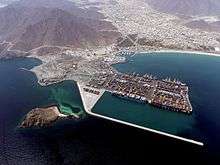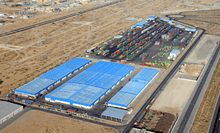Gulftainer
 Gulftainer logo | |
| Limited Liability Company | |
| Industry | Port Operations & Management and Transport & Logistics |
| Founded | 1976 |
| Headquarters | Sharjah, United Arab Emirates |
Area served | United Arab Emirates, Iraq, Lebanon, Saudi Arabia, Brazil, Pakistan, and the United States |
| Products | Port investment, development, management and operations. Transport of all cargo types including: project cargo; Third party logistics; freight forwarding; contract logistics; container repairs and minor ship repairs |
| Services | Ports and logistics management |
| Parent | Crescent Enterprises |
| Subsidiaries | Momentum Logistics |
| Website |
gulftainer |
Gulftainer is an independently owned, global port operator with its corporate head office in the United Arab Emirates (UAE). Established in 1976, the company today manages about 40% of all the major container terminal facilities in the Middle East and has business operations in seven countries around the world.[1] The company's primary business is container, with additional and bulk cargo handling within port terminals and logistics cities.
History
Gulftainer was formed in 1976 to manage and operate the Sharjah Container Terminal (SCT) on behalf of the Sharjah Port Authority. Ten years later a concession was awarded to Gulftainer to manage and operate Khorfakkan Container Terminal (KCT) in Khorfakkan Port and the container terminal in Hamriyah Port, Sharjah. In 2004, Gulftainer expanded beyond the UAE, initially as a consultant to the Kuwait Port Authority. Later the same year, it inaugurated the purpose-built Sharjah Inland Container Deport (SICD) near the Sharjah–Dubai border.[2] Further development continued into South Asia and Africa in 2006,[3] as it commenced transport and logistics joint ventures with Pak Shaheen in Pakistan, and UAE based Al Marwan, to manage and operate Moroni Port in the Comoros Islands.

In 2008, a transport and logistics joint venture with Demas International in Turkey lead to Gulftainer launching Momentum Logistics, a full-service third-party logistics company. Momentum was soon awarded a contract to manage logistics and vessel operations at Ruwais Port in Abu Dhabi (UAE) in 2009.

The Iraqi Port Authority granted Gulftainer concessions to operate cargo facilities in Umm Qasr Port, the primary marine gateway into Iraq. Terminal operations started in 2010; and were expanded in 2012. In 2013, Gulftainer commenced development of a logistics city development in Umm Qasr,[4] which is now fully operational.
In 2011, Gulftainer signed a major joint venture agreement with Prominvest, the financial and investment arm of Russian State Corporation, Russian Technologies to develop projects in Russia.[5] The company made its first expansion into South America, by establishing terminal operations in the Port of Recife, Brazil in 2012. In the same year Gulftainer was awarded the concession to develop and operate a new container terminal at the Port of Tripoli in Northern Lebanon[6] The concession is for 25 years with an investment of over USD 60 million in new equipment and machinery. In June 2013, Gulftainer completed a major acquisition by securing the majority shareholding in Saudi Arabia's Gulf Stevedoring Contracting Company (GSCCO) almost doubling the company size. This acquisition made Gulftainer the largest port operator in the Middle East with regard to the number of terminals managed.[7]

In June 2014, Gulftainer signed a 35-year concession with the Canaveral Port Authority in Florida, USA to operate and develop its container and multipurpose cargo terminal. The terminal, is Gulftainer's first venture in the United States.[8]
The Gulftainer Group operates and manages ports and logistics businesses in several countries, including the UAE, Iraq, Saudi Arabia, Lebanon, the USA, Pakistan and Brazil.
Timeline

Operations

In the UAE, Gulftainer operates three container terminals on behalf of the Sharjah Port Authority:
- Khorfakkan Container Terminal, located on the east coast, handling around four million TEUs annually.
- Sharjah Container Terminal, based in Port Khalid, which is a major import–export facility for industries located in Sharjah, in the UAE's industrial zones, and in the Northern Emirates, along with container facilities in Hamriyah Port.
- Sharjah Inland Container Depot (SICD), a large inland terminal owned and operated by Gulftainer that provides 35 covered warehouses, custom clearance, storage facilities and a container depot.
Gulftainer operates the Iraq Container Terminal and the Iraq Project Terminal at the Umm Qasr Port. In Brazil, Gulftainer manages operations within the Port of Recife, and provides stevedoring services at the Port of Suape; in Lebanon from 2016, it will operate facilities in the Port of Tripoli; whilst in the USA, Gulftainer commenced operations of all container and multi cargo facilities in Port Canaveral, Florida in January-2016.[8] Gulftainer's non-port business activities include providing 3PL (Third party logistics) services within the UAE, Iraq and Pakistan. Momentum Logistics, Gulftainer's logistics subsidiary, was established in 2008; it manages the group's transportation and logistics operations throughout the Middle East and Asia.[9]
The company also owns and operates two logistics cities: the Sharjah Inland Container Depot on the Dubai—Sharjah border with services ranging from customs clearance, warehousing and storage, to inland transportation, and in Iraq, the Umm Qasr Logistics Centre, a fully integrated logistics facility, spread over an area of 750,000 square metres (8,100,000 sq ft).[4] enabling the direct movement of cargo from the Iraq Container Terminal (IPT) in the North Port, without the need for port side customs clearance. In Saudi Arabia, the Company operates container terminals within Jeddah Islamic Port and Jubail Commercial Port.
Recognition
KCT was recognized as the most productive port in Europe, the Middle East and Africa (EMEA) by the Journal of Commerce port productivity report for 2013. It was also awarded a second place in the top 10 terminals in EMEA and third in the top 10 worldwide ports category.[10] Gulftainer's KCT was the first port of call[1] in the Middle East for CMA CGM's Marco Polo – at the time, the world's largest container ship – on its maiden voyage across the Persian Gulf.
In April 2015, KCT was awarded the SCATA "Shipping Port of the Year."[11] This was followed by the Gulftainer company receiving the 'Port Operator of the Year" Award from Lloyds List at the Middle East and Indian Subcontinent Awards ceremony in December.[12] This award recognises the company or port authority that has maintained the highest standards of operational efficiency and customer service throughout the year.[13]
See also
References
- 1 2 "Gulftainer sees 24% increase in 2012 trade volumes.". Gulftainer. 17 Feb 2013. Retrieved 8 March 2015.
- ↑ "Sharjah Inland Container Depot". Retrieved 21 April 2014.
- ↑ "Facts and Figures". Gulftainer.
- 1 2 "Umm Qasr Logistics Centre". Gulftainer. Retrieved 8 March 2015.
- ↑ "Gulftainer to invest $500m in Russia". Trade Arabia. Retrieved 21 April 2014.
- ↑ "Lebanon signs contract with Gulftainer for Tripoli. port". 9 October 2013. Retrieved 21 April 2014.
- ↑ "Global Container Terminal Operators annual review and forecast 2013". Drewry.
- 1 2 "Gulftainer Expands into USA". Gulftainer. Retrieved 8 March 2015.
- ↑ "Container Repair". Momentum. Retrieved 21 April 2014.
- ↑ Mongelluzzo, Bill. "Port Productivity" (PDF). JOC Group. Retrieved 8 March 2015.
- ↑ "WINNERS 2015". Arabian Supply Chain. Arabian Supply Chain. Retrieved 15 August 2016.
- ↑ "Gulftainer wins 'Port Operator Award' at Lloyd's List Middle East & Indian Subcontinent Awards 2015". Zawya. 15 December 2015. Retrieved 15 August 2016.
- ↑ "Port Operator Award". Lloyd's List. Retrieved 15 August 2016.